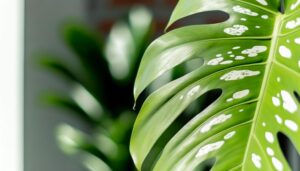How Do I Treat Yellow Spots on Monstera Leaves? Solutions!
To treat yellow spots on Monstera leaves, start by inspecting for pests like spider mites and scale insects using a magnifying glass. Check if the soil is compacted or poorly draining.
Use a hygrometer to assess soil moisture and verify it’s not waterlogged. Examine light exposure, confirming bright, indirect light using a light meter.
Inspect roots for rot; trim affected roots and repot with well-draining soil. Test soil for nutrient deficiencies and amend as necessary.
Prune yellowed leaves with sterilized shears and apply insecticidal soap or balanced fertilizer as needed. Many intricacies influence plant health, necessitating a deeper understanding.
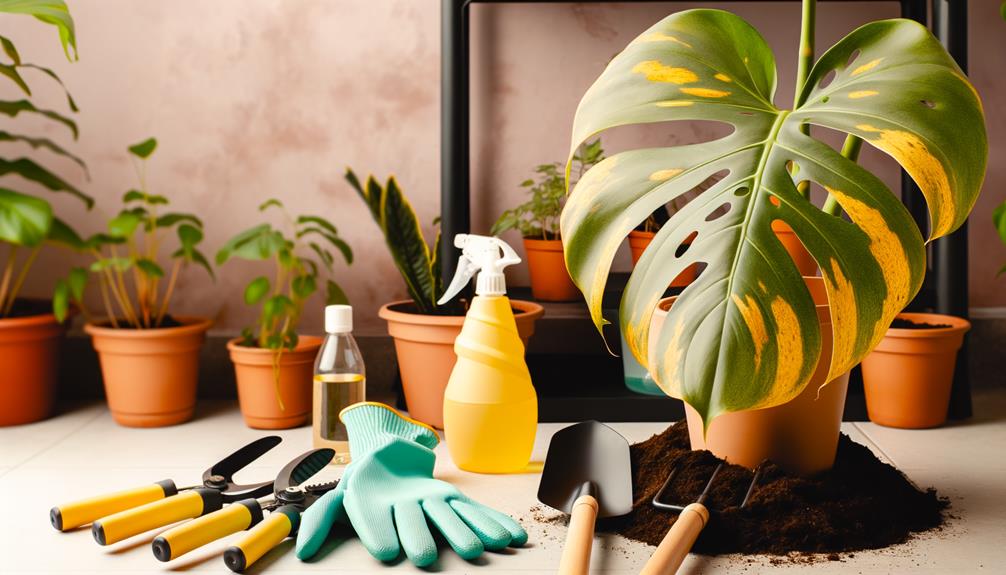
Key Takeaways
- Inspect leaves and stems for pests; treat with insecticidal soap or neem oil.
- Check soil moisture; adjust watering routine to prevent overwatering or underwatering.
- Evaluate lighting conditions; ensure Monstera receives bright, indirect light.
- Test soil for nutrient deficiencies and amend with appropriate fertilizers.
- Prune yellowed leaves to prevent disease spread and encourage healthy growth.
Identify the Cause
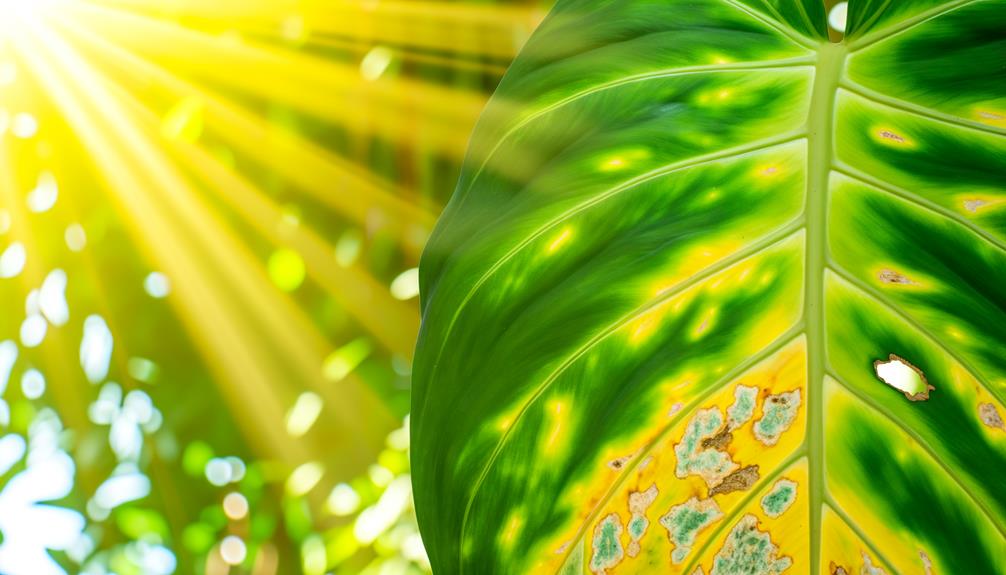
To effectively treat yellow spots on Monstera leaves, you must first identify the underlying cause. This can range from improper watering to pest infestations. Begin by thoroughly inspecting the leaves and stems. Look for signs of pests like spider mites or scale insects, which often leave tiny webs or sticky residue.
Nutrient deficiencies, particularly nitrogen or magnesium, can also cause yellowing. Examine the soil for compaction or poor drainage, as this can lead to root rot, further exacerbating leaf discoloration. Additionally, assess lighting conditions; insufficient light can stress the plant, leading to yellow spots.
Assess Watering Habits
To evaluate your watering habits, begin by measuring soil moisture levels using a hygrometer to make sure they’re within best ranges.
Follow watering frequency guidelines based on your Monstera’s environment, usually allowing the top inch of soil to dry out between waterings.
Soil Moisture Levels
Consistently monitoring the soil’s moisture levels is crucial for preventing yellow spots on Monstera leaves. By evaluating the moisture content, you can determine if overwatering or underwatering is causing the discoloration.
Use a soil moisture gauge to get accurate readings. Aim for soil that feels slightly moist but not waterlogged. Overly saturated soil can lead to root rot, while excessively dry soil stresses the plant, both resulting in yellow spots.
Here’s a helpful guide:
| Soil Moisture Level | Symptoms on Leaves | Action Required |
|---|---|---|
| Too Wet | Yellow, mushy spots | Reduce watering, improve drainage |
| Ideal | Healthy, green leaves | Maintain current practices |
| Too Dry | Yellow, crispy spots | Increase watering frequency |
Understanding these signs ensures the best Monstera health.
Watering Frequency Guidelines
Understanding how frequently to water your Monstera is crucial for preventing yellow spots, as improper watering practices are a primary cause of leaf discoloration. Monstera plants require a balanced approach: neither too dry nor excessively saturated. Overwatering leads to root rot, depriving roots of oxygen, while underwatering stresses the plant, causing leaves to turn yellow.
Aim to water when the top inch of soil feels dry to the touch. Follow a consistent schedule, typically every 1-2 weeks, depending on environmental factors such as humidity and light levels. Always use room-temperature water to avoid shocking the roots.
Monitoring your plant’s specific needs ensures ideal hydration, preventing the onset of yellow spots and promoting overall plant health.
Drainage Effectiveness
Effective drainage is crucial in evaluating watering habits, as it prevents water from pooling at the bottom of the pot and causing root rot. Confirming that your Monstera’s pot has adequate drainage holes is essential. Use a well-aerated soil mix, preferably one that includes components like perlite or bark to enhance water flow. Check the saucer beneath the pot regularly to verify it’s not retaining excess water.
You can take several steps to improve drainage:
- Inspect drainage holes: Verify they’re unobstructed.
- Soil composition: Use a mix with good aeration properties.
- Pot size: Choose a pot that’s not excessively large.
- Elevate the pot: Use pot feet or a plant stand to enhance air circulation.
These practices will reduce yellow spots caused by overwatering.
Check for Root Rot
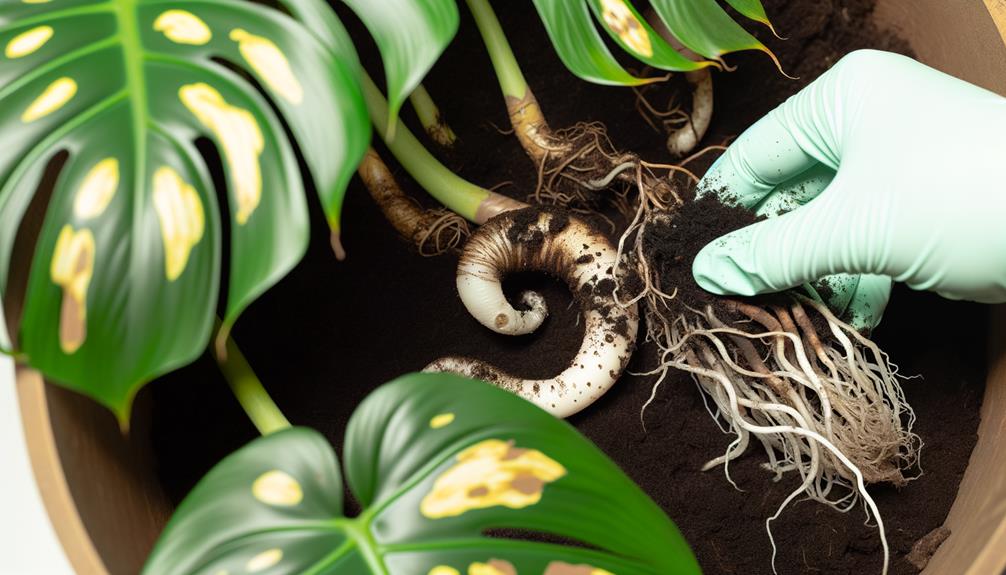
Start by gently removing your Monstera from its pot to inspect the roots for signs of rot, such as a mushy texture, dark coloration, or a foul odor. These symptoms indicate root rot, often caused by overwatering or poor drainage. A healthy root system should be firm and white or light tan.
Use sterilized scissors to trim away any affected roots. Repot the Monstera in fresh, well-draining soil, and ensure the new pot has adequate drainage holes. Reducing watering frequency and improving soil aeration can prevent future rot. Monitoring soil moisture with a meter can help maintain optimal conditions.
Addressing root rot promptly is essential to stop the spread and restore the plant’s health.
Inspect for Pests
Carefully inspect your Monstera leaves and stems for common pests like spider mites, mealybugs, and thrips, as these insects can cause yellow spots by feeding on the plant’s sap. Use a magnifying glass for a detailed inspection, focusing on the undersides of leaves and near the stems where these pests often congregate.
Look for signs such as:
- Tiny webbing (indicative of spider mites)
- White, cotton-like masses (mealybugs)
- Slender, black insects (thrips)
- Sticky residue or honeydew (general pest excretion)
Early detection is essential for effective treatment. Insecticidal soap or neem oil can be applied to eradicate these pests. Consistently monitor your plant for recurrence, and maintain a regular cleaning routine to prevent infestations.
Evaluate Sunlight Exposure
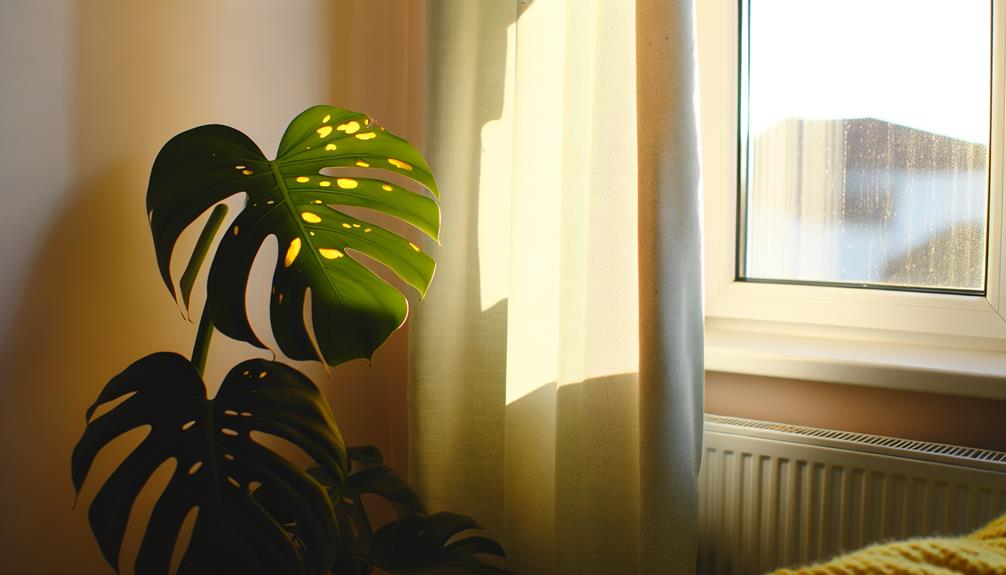
Evaluating your Monstera’s sunlight exposure is crucial as both inadequate and excessive light can lead to yellow spots on the leaves. Place your Monstera in bright, indirect light for best growth.
Direct sunlight can cause photodamage, leading to chlorosis, which manifests as yellow spots. Conversely, insufficient light hampers photosynthesis, resulting in poor chlorophyll production and yellowing leaves. Use a light meter to measure the intensity; 1000 to 2500 lux is ideal.
Observe the leaf orientation and color changes to gauge lighting sufficiency. If the leaves lean toward a light source or develop a pale hue, adjust positioning. Rotating the plant periodically ensures even light distribution, preventing localized stress and promoting uniform health.
Ensure Proper Humidity
To alleviate yellow spots on Monstera leaves, you should monitor humidity levels closely, as these tropical plants thrive in high humidity. Using a hygrometer, make sure the air moisture remains between 60-80%, and consider using a humidifier to maintain ideal conditions.
Grouping plants together can also create a microenvironment with increased humidity, benefiting all nearby foliage.
Monitor Humidity Levels
Maintaining ideal humidity levels is essential for preventing yellow spots on Monstera leaves, as these plants thrive in environments with 60-80% humidity. Start by using a hygrometer to accurately measure the humidity in your Monstera’s surroundings.
Inadequate humidity can lead to stress, causing yellow spots and other health issues. You should regularly check humidity levels, particularly during seasonal changes when indoor air can become drier.
Remember to:
- Observe leaf condition: Dry, crispy edges indicate low humidity.
- Group plants together: Increases local humidity due to collective transpiration.
- Mist leaves: Provides temporary humidity boost.
- Use pebble trays: Evaporation from water-filled trays elevates humidity.
These actions help maintain ideal conditions, ensuring your Monstera remains vibrant and healthy.
Use Humidifiers Effectively
If grouping plants and misting leaves aren’t sufficient to maintain the necessary moisture for your Monstera, using a humidifier can be a highly efficient solution. Monstera plants thrive in environments with 60-80% moisture. A humidifier releases water vapor into the air, raising moisture levels and mitigating leaf yellowing caused by dry conditions.
Place the humidifier near your Monstera but not too close, to avoid over-saturation. Opt for a model with a hygrometer to monitor ambient moisture accurately. Regularly clean the humidifier to prevent microbial growth, which could harm your plant.
Group Plants Together
Grouping plants closely can create a microenvironment with higher moisture levels, which is crucial for preventing yellow spots on Monstera leaves. When plants are clustered, transpiration from each leaf increases ambient dampness. This moisture boost helps Monstera leaves maintain their vibrant green color.
Scientific studies show that higher moisture levels reduce the rate of transpiration stress, a common cause of yellowing.
Consider implementing the following strategies:
- Cluster plants together to maximize moisture levels.
- Utilize moisture trays filled with water and pebbles underneath the plants.
- Mist leaves with water to replicate natural rainforest conditions.
- Monitor moisture levels with a hygrometer to ensure ideal ranges (60-80%).
Examine Soil Quality
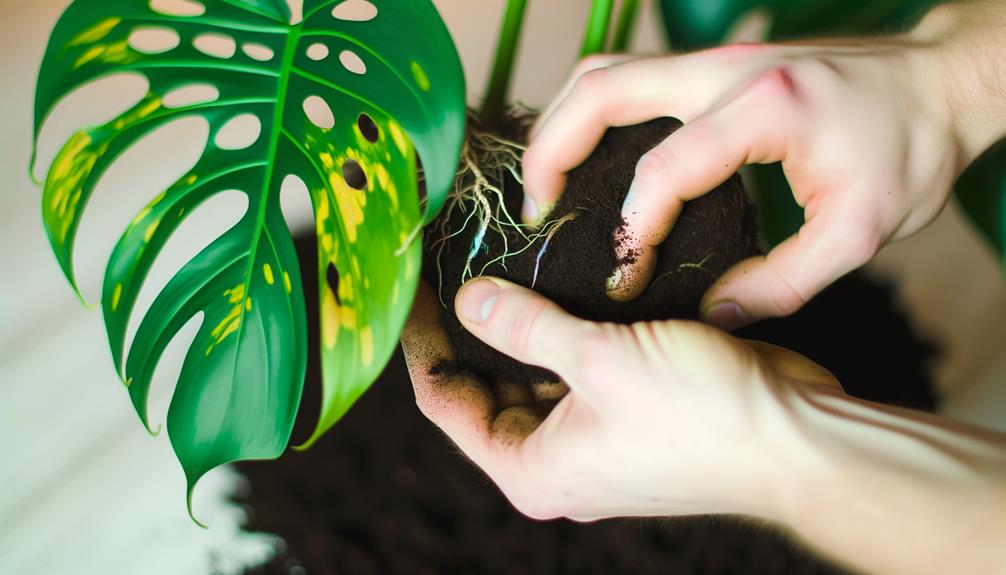
Analyzing the soil quality is important, as poor drainage or nutrient imbalances can directly contribute to yellow spots on Monstera leaves. Start by examining the soil’s drainage capabilities; waterlogged soil can lead to root rot, causing leaf discoloration.
Test the soil’s pH level, making sure it falls within the best range of 5.5 to 7.0 for Monsteras. Use a soil test kit to check for nutrient deficiencies, particularly nitrogen, magnesium, and potassium, which are necessary for healthy foliage.
If necessary, amend the soil with organic matter or specific fertilizers to address any imbalances. Also, make sure that the pot has adequate drainage holes to prevent water accumulation.
Regularly monitor soil moisture levels to maintain an ideal environment for your Monstera.
Prune Affected Leaves
Once you’ve assessed and improved the soil quality, it’s important to trim the affected leaves to prevent the spread of any potential disease and to encourage new, healthy growth. Carefully sterilize your pruning shears to avoid introducing pathogens.
Cut the leaves at the base, making a clean, sharp cut to minimize plant stress. Removing yellowed leaves allows the plant to redirect its energy towards healthier foliage and promotes efficient photosynthesis.
By taking these steps, you’ll:
- *Prevent the spread of pathogens*
- *Encourage vigorous new growth*
- *Enhance photosynthetic efficiency*
- *Boost overall plant health*
Trimming is a crucial horticultural practice supported by research, demonstrating its effectiveness in maintaining plant health and vigor. This proactive measure ensures your Monstera remains lush and vibrant.
Apply Suitable Treatments
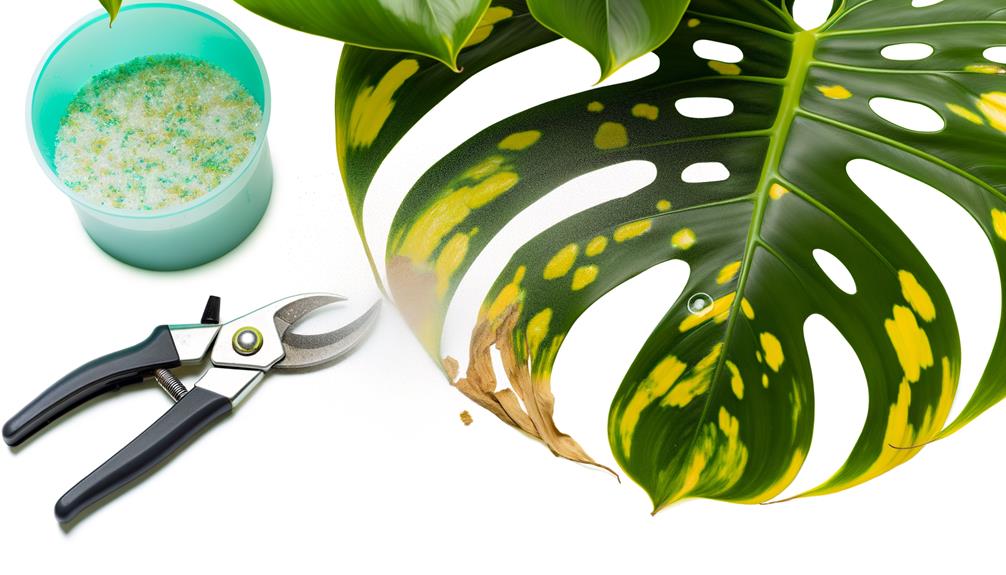
Select appropriate treatments to address the underlying causes of yellow spots on your Monstera leaves, ensuring you target issues such as nutrient deficiencies, pest infestations, or fungal infections.
For nutrient deficiencies, apply a balanced, water-soluble fertilizer rich in nitrogen, phosphorus, and potassium.
To combat pest infestations, utilize insecticidal soap or neem oil, ensuring thorough coverage of the leaves.
For fungal infections, use a fungicide containing copper or sulfur, following the manufacturer’s instructions for application rates and frequency.
Regularly monitor your plant’s condition, adjusting treatments as necessary based on observed effectiveness.
Always quarantine affected plants to prevent the spread of pests or pathogens.
Conclusion
By identifying the cause, evaluating watering habits, checking for root rot, inspecting for pests, evaluating sunlight exposure, maintaining proper humidity, examining soil quality, and pruning affected leaves, you can effectively treat yellow spots on your Monstera leaves.
Prioritize consistent care, adopt evidence-based treatments, and monitor plant health regularly.
Adhering to these steps will prevent recurrence and promote vibrant, healthy growth.
Remember, a proactive approach guarantees your Monstera thrives, free from unsightly yellow spots.



